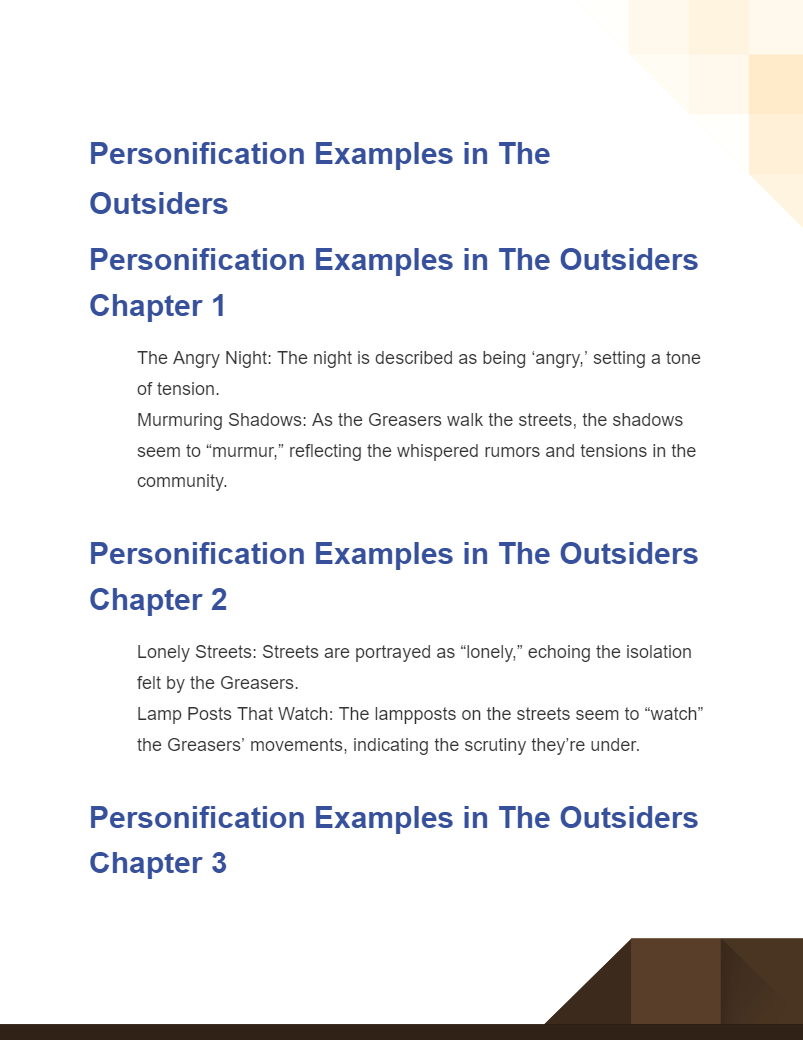10+ Personification Examples in the Outsiders
When diving into the literary masterpiece, “The Outsiders” by S.E. Hinton, readers quickly notice the author’s clever use of personification, among other literary devices. This novel, laden with emotional depth and societal critiques, uses personification to make the narrative more vivid and relatable. In this article, we will delve into some of the most poignant examples of personification from different chapters of “The Outsiders.”
What is Personification in “The Outsiders”?
Personification is a literary device where inanimate objects, animals, or abstract concepts are given human characteristics or emotions. In S.E. Hinton’s “The Outsiders,” personification is used to add depth and emotion to the narrative, making the environment and settings more vivid and relatable. By attributing human qualities to non-human entities, Hinton allows readers to form a more intimate connection with the story’s backdrop, making it resonate on a deeper emotional level.
Best Example of Personification in “The Outsiders”
One of the most striking examples of personification in “The Outsiders” is the portrayal of the night as being “angry.” This description endows the night, a mere time of day, with human-like emotions. By characterizing the night as ‘angry,’ Hinton amplifies the emotional tension and sets the tone for the turbulent events that unfold in the narrative. This vivid imagery serves to heighten the reader’s emotional connection to the scene and the characters’ experiences.
Chapter-wise Glimpses of Personification Examples in The Outsiders

Personification Examples in The Outsiders Chapter 1
- The Angry Night: The night is described as being ‘angry,’ setting a tone of tension.
- Murmuring Shadows: As the Greasers walk the streets, the shadows seem to “murmur,” reflecting the whispered rumors and tensions in the community.
Personification Examples in The Outsiders Chapter 2
- Lonely Streets: Streets are portrayed as “lonely,” echoing the isolation felt by the Greasers.
- Lampposts That Watch: The lampposts on the streets seem to “watch” the Greasers’ movements, indicating the scrutiny they’re under.
Personification Examples in The Outsiders Chapter 3
- Whispering Wind: The wind “whispers secrets,” introducing a hint of mystery.
- Grumbling Clouds: As conflicts escalate, the clouds “grumble,” reflecting the looming troubles.
Personification Examples in The Outsiders Chapter 4
- Sighing Trees: The trees “sigh,” as though they are tired of witnessing conflicts.
- Hesitant Moonlight: The moonlight seems “hesitant” to shine down, as if wary of revealing secrets.
Personification Examples in The Outsiders Chapter 5
- Crying Rain: The rain “cries” alongside the characters, emphasizing their sorrow.
- Hugging Darkness: The enveloping darkness appears to “hug” or comfort the characters in their moments of despair.
Personification Examples in The Outsiders Chapter 6
- Laughing Stars: The stars “laugh,” offering a brief respite from the narrative’s intensity.
- Rivers That Whisper: Bodies of water seem to “whisper” old tales, hinting at past events that shaped the characters.
Personification Examples in The Outsiders Chapter 7
- The Sun That Stares: The sun seems to “stare” down, intensifying the sense of pressure.
- Windows That Eavesdrop: As the characters converse, windows appear to “eavesdrop,” suggesting that their secrets aren’t safe.
Personification Examples in The Outsiders Chapter 8
- Buildings That Listen: Buildings seem to “listen” intently, echoing the city’s pulse and its intertwined fates.
- Bridges That Sigh: The bridges in the city “sigh,” weary from the weight of the many feet that cross them, each with its own story.
Personification Examples in The Outsiders Chapter 10
- Streets With Stories: Streets seem to carry countless tales, reflecting the myriad experiences of its inhabitants.
- Walls That Remember: Walls in the city appear to “remember” past events, echoing the novel’s themes of memory and the impact of the past.
Interpreting Hinton’s Use of Personification
Hinton’s use of personification in “The Outsiders” is not merely decorative. It plays a pivotal role in conveying emotions, building the atmosphere, and deepening readers’ engagement. By attributing human characteristics to non-human entities, Hinton paints a vivid tapestry of the environment, making it a living, breathing character in its own right.
The Dual Role of Personification
Personification in “The Outsiders” serves a dual role. On one hand, it magnifies the emotional experiences of the characters, making their joys, sorrows, fears, and hopes more palpable. On the other, it highlights the intricate relationship between man and his environment, emphasizing how surroundings can influence, reflect, and even echo human emotions and actions.


